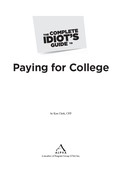Federal Tax Deductions for Education
These deductions for educational expenses aren’t as juicy as the tax credits we’ve just discussed, but they’re still better than a sharp stick in the eye. Of course, what they’ll actually save you depends on your marginal tax bracket, so you need to know how to find that.
U.S. taxpayers are taxed in progressive brackets. That means that as someone makes more and more money, some of his income will fall into the higher brackets, resulting in it (but not all of his income) being taxed at a higher rate. So unlike the value of a tax credit, which directly offsets taxes owed, a tax deduction only reduces the amount of income that is taxed at a certain bracket.
For example, if a married couple reports $74,000 in taxable income, everything above $68,000 is taxed at 25 percent for federal income tax purposes. So if someone claims the maximum $4,000 Tuition and Fees Deduction (not a credit), it reduces the amount of income that will be taxed at 25 percent by $4,000. This in turn saves this specific taxpayer $1,000.
The Tuition and Fees Deduction
Although not as hefty as the AOTC or the Lifetime Learning Credit, the Tuition and Fees Deduction is still considered meatier than many other deductions. That is in part due to its above-the-line status, which means you don’t need to itemize your other deductions to claim this. Normally, with things like medical expenses and charitable deductions, you are able to claim them only if all your deductions exceed a certain combined amount. Again, the Tuition and Fees Deduction, which is technically known as an adjustment to income, does not require a taxpayer to itemize her deductions on a Schedule A to reap the benefits.
The Tuition and Fees Deduction for 2010 is $4,000, meaning that if you have $4,000 in qualified education expenses for a student, you can deduct them from the income you report on your tax return. Again, you cannot use both this deduction and one of the education tax credits previously covered. Because there is no way that this deduction can hold a candle to the AOTC, this deduction is primarily used by students and parents whose income is too high to be able to claim the Lifetime Learning Credit.
The Student Loan Interest Deduction
If you’re currently making student loan payments or will in the future (and there is a good chance you will if you’re reading this book), it’s important to realize that you can deduct the interest you pay in any given year. Notice that I said interest you pay, not interest that is charged. That’s because you can only deduct the interest portions of payments you actually made. If $1,000 in interest was added to your loan this year, but you did not actually make a payment, you cannot deduct anything.
Don’t get too hung up on the computation here, though. Thankfully, your student loan lender will send you a form at the end of the year—called a Form 1098-E—identifying exactly how much student loan interest you paid. All you need to do is plug that number into your tax preparation software or hand it to your tax preparer, and you’re all set.
Like the Tuition and Fees Deduction, the Student Loan Interest Deduction is also an above-the-line deduction, meaning you don’t need to itemize your other deductions to be able to utilize it. But, the deduction itself is limited to $2,500 for 2010.

CHEAT SHEET
There’s no rule that says you can’t begin repaying student loans while you’re still in school. In fact, many students make a point of paying the interest that accrues on their student loans each month to keep the loan from growing and to capture an extra deduction. If you have some spare cash lying around after you pay your college expenses, this would be a great use for that money.
..................Content has been hidden....................
You can't read the all page of ebook, please click here login for view all page.
